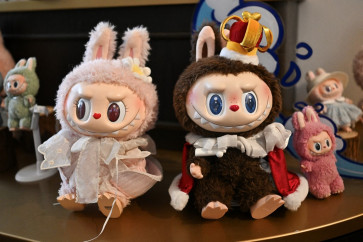Popular Reads
Top Results
Can't find what you're looking for?
View all search resultsPopular Reads
Top Results
Can't find what you're looking for?
View all search resultsA tour of the sacred feminine
In the summer of 1998, writer Sue Monk Kidd and her then 22-year-old daughter Ann went to Greece on a mother-daughter bonding trip
Change text size
Gift Premium Articles
to Anyone

In the summer of 1998, writer Sue Monk Kidd and her then 22-year-old daughter Ann went to Greece on a mother-daughter bonding trip. That trip was the beginning of a joint memoir, published more than 10 years later.
Although a simple story at times offering trite observations or self-indulgent navel gazing, Traveling with Pomegranates delves into many timeless and universal ideas of what it means to be a woman - whether Maid, Mother or Crone - and explores, on a personal level, women's relationships with other women and themselves, and women's need to find their "necessary fire".
When the narrative begins, at the National Archaeological Museum in Athens, the two women are at transitional points in their lives. Sue is facing her 50th birthday, feeling "for the first time the overtures of an ending", her body "engaged in vague, mutinous behaviors". Sue's dilemma is that she is becoming an "Old Woman" and asks if the loss of her physical fertility means the end of her creativity and identity: "What will be born in me now?"
Ann is at the opposite transitional phase - the passage into womanhood, the need to find her path in life. On an earlier trip to Greece, Ann had had an epiphany at the Acropolis - that she would study ancient Greek history. But when she returns to the Acropolis with her mother, that dream has been shattered, she feels "abandoned . by the future, by my own self, by the promise of life" - the graduate school of her choice turned her down and, unable to cope with the rejection, she has sunk into depression. She hopes for another epiphany but gets nothing, and must work out what she is going to do with her life the hard way.
The opening scene features a bas-relief of Demeter and Persephone, the archetypal mother and daughter of Greek mythology. Sue recounts the story, telling how Hades, lord of the dead, abducts Persephone into the underworld; how Demeter, great earth goddess, despairing for her lost daughter, lets the crops wither; how Persephone returns to Earth, but first swallows pomegranate seeds that ensure she must return to the underworld for part of each year; how mother and daughter are reunited on the first day of spring; how each year when Persephone returns to the underworld, winter falls again.
This myth becomes the metaphor for the central relationship, and suggests the titles for the three parts of the book: Loss, Search, Return. However, each also finds the myth's relevance for her own personal experience: Sue seeks a way to unite the young and old within herself; Ann sees how her depression is a journey to the underworld, from which she must return to be with her adult self.
As the pomegranate (a "lavish symbol of fertility") is central to the myth, Sue buys glass pomegranate charms for them; these become part of the collection of icons, statues, trinkets, flowers and other symbols each collects on her personal journey.
The narrative follows the rest of their short trip to Greece and Turkey, a trip to France "in quest of sacred feminine images in art and history", another trip to Greece, and the time in between in South Carolina, the whole spanning a two-year period where each finds the answers to the starting problem through consideration of and supplications to the sacred feminine images they encounter: Demeter, Persephone, Athena, Hestia, Hecate, Joan of Arc and many, many versions of the Virgin Mary.
Mother and daughter share the memoir as alternate narratives, creating a dueling banjo effect where each describes the same event in her own way, while also taking the narrative forward. These are basically happy, uncomplicated women with good relationships, solid finances, and no hint of trauma: The sole driver of the narrative is their spiritual journey, the quest to "find themselves".
Of the two narratives, Sue's is probably the more interesting, thanks to her exploration of feminine myths and concepts. Hers is not a necessarily profound or academic exploration, but she makes no pretensions to academic rigor. Rather, her narrative is determinedly personal, full of her own symbolic dreams, her encounters with the divine and the "signs" from the Virgin Mary or whoever is guiding her in her life - and at every turn she seems to believe in something "prodding" or "guiding" her. At any rate for Sue it works out - the novel she is encouraged to write after a "sign" is the bestseller The Secret Life of Bees (later adapted into a movie of the same name); the novel features a Black Madonna, which Sue learned about during her trips.
Ann's entries are, curiously, more trite and adolescent - curiously, because the book was published so long after the fact. In her narrative, Ann comes across as an immature 22-year-old, wrapped up in her own minor concerns, not yet able to see that one setback is not the end of the world. Although she is in her early 30s now, the narrative bravely portrays the solipsism, awkwardness and self-loathing of her youth, which fades as she finds her true calling.
As a travelogue or tale of personal challenge, this memoir merits only passing interest: The women have easy lives, their main frustration their desire to write, and their travels are standard tourist fare. The narrative is at turns sentimental; the writing, while generally lucid, lapses occasionally into vagueness.
Value is drawn from this memoir through embracing its basic assumption that it is necessary to build a rich spiritual inner life, and that this can be done through encounters with sacred images, archetypes and symbols. The narrative can create a channel for the willing reader to think deeply about what it means to be a woman and to reconnect with ancient myths and images, of any cultures, as a way of learning how we each fit into the world.
Traveling with Pomegranates: A Mother-Daughter Story
Sue Monk Kidd & Ann Kidd Taylor
Viking, 282 pages









